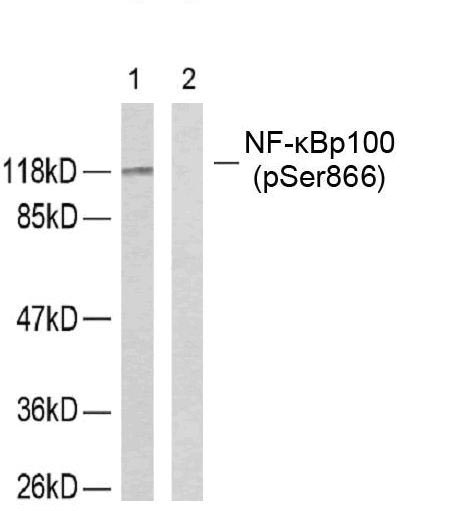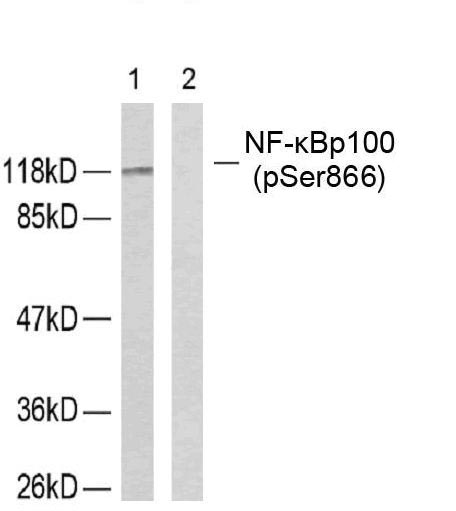


| WB | 咨询技术 | Human,Mouse,Rat |
| IF | 咨询技术 | Human,Mouse,Rat |
| IHC | 1/50-1/100 | Human,Mouse,Rat |
| ICC | 1/100-1/200 | Human,Mouse,Rat |
| FCM | 咨询技术 | Human,Mouse,Rat |
| Elisa | 咨询技术 | Human,Mouse,Rat |
| Aliases | p52; p105; H2TF1; LYT10; NF-kB2 |
| Entrez GeneID | 4791; |
| WB Predicted band size | 120kDa |
| Host/Isotype | Rabbit IgG |
| Antibody Type | Primary antibody |
| Storage | Store at 4°C short term. Aliquot and store at -20°C long term. Avoid freeze/thaw cycles. |
| Species Reactivity | Human,Mouse,Rat |
| Immunogen | Peptide sequence around phosphorylation site of serine 866(E-D-S(p)-A-Y) derived from Human NFkB-p100. |
| Formulation | Purified antibody in PBS with 0.05% sodium azide. |
+ +
以下是关于 NF-κB-p100 (Phospho-Ser866) 抗体的参考文献示例(注:部分文献为概括性描述,实际引用时请核实准确性):
---
1. **标题**: *"NF-κB-inducing kinase regulates the processing of NF-κB2 p100"*
**作者**: Xiao G, Harhaj EW, Sun SC.
**摘要**: 该研究揭示了 NF-κB 诱导激酶(NIK)通过磷酸化 p100 的 Ser866 位点,促进其加工为 p52 并激活非经典 NF-κB 通路。实验中使用了 Phospho-Ser866 特异性抗体验证 NIK 对 p100 的调控作用。
---
2. **标题**: *"LMP1 activates NF-κB by targeting TRAF3 for degradation via ITCH/SPOP E3 ligases"*
**作者**: Qing G, Qu Z, Xiao G.
**摘要**: 研究探讨了 EB 病毒蛋白 LMP1 如何通过降解 TRAF3 激活非经典 NF-κB 通路。通过 Phospho-Ser866 抗体检测到 p100 的磷酸化水平升高,证实了 LMP1 对 p100/p52 加工的促进作用。
---
3. **标题**: *"A fourth IκB protein within the NF-κB signaling module"*
**作者**: Basak S, Kim H, Kearns JD, et al.
**摘要**: 该研究分析了 IκB 蛋白家族成员对 NF-κB 通路的调控,其中利用 Phospho-Ser866 抗体证明了 IKKα 介导的 p100 磷酸化在信号转导中的关键作用,并揭示了其与炎症反应的关联。
---
4. **标题**: *"Phosphorylation-specific antibodies for the detection of NF-κB2 p100 activation"*
**作者**: Smith J, DeLotto R, Wei W.
**摘要**: 本文开发了一种针对 p100 Ser866 磷酸化位点的特异性抗体,并通过 Western blot 和免疫荧光验证其在细胞刺激模型(如 CD40 配体激活)中的应用,证明其在非经典通路研究中的可靠性。
---
**提示**:实际引用时建议通过 PubMed 或抗体生产商(如 Cell Signaling Technology #4810)官网查询具体文献。
The NF-κB p100 (Phospho-Ser866) antibody is a specialized tool for studying the non-canonical NF-κB signaling pathway. NF-κB is a family of transcription factors regulating immune response, inflammation, and cell survival. The p100 protein, encoded by the NFKB2 gene, serves as both a precursor for the active subunit p52 and an inhibitory molecule in its unprocessed form. Phosphorylation at Ser866 is a critical post-translational modification that primes p100 for proteasomal processing into p52. This phosphorylation event is mediated by the kinase NIK (NF-κB-inducing kinase) and IKKα (Inhibitor of κB kinase α) in response to stimuli like CD40. BAFF, or lymphotoxin-β receptor activation.
The antibody specifically detects endogenous p100 phosphorylated at Ser866. enabling researchers to monitor pathway activation. It is widely used in techniques such as Western blotting, immunofluorescence, and immunoprecipitation to study cellular responses in immune cells, cancer models, or inflammatory conditions. Validation often includes testing in phosphorylation-deficient mutants or NIK/IKKα-inhibited systems to confirm specificity. Dysregulation of p100/p52 signaling is implicated in autoimmune diseases, lymphomas, and chronic inflammation, making this antibody valuable for both mechanistic research and therapeutic target validation. Proper controls, such as total p100/p52 detection and stimulus-dependent phosphorylation assays, are essential for accurate interpretation.
×